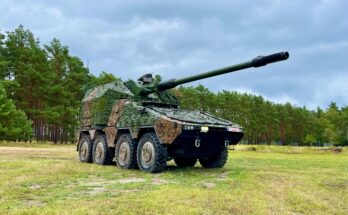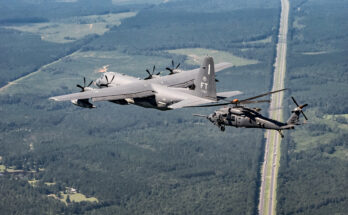by Dan Darling, International Military Markets Analyst, Forecast International.
As the crisis in Ukraine unfolded in 2014, risk perceptions stirred across the European continent. Defense policy reassessments and heightened security footing skewed depending on geography, but across Europe in general there was a sense of renewed threat emanating from Russia.
By September 5, 2014, members of NATO were pledging to gradually increase their military investment levels upward in an effort to meet the Alliance’s requirement that a minimum of 2 percent of annual GDP be allocated toward defense within a decade. According to Forecast International research, the Wales Summit Declaration marked the point where splits within European defense funding commitments became readily apparent.
The immediate result has been a sharp divergence between the newer NATO nations along Europe’s eastern periphery and the older European NATO nations in terms of how government funding has been redirected toward their respective militaries.
For instance, the military “backbone” members of the European NATO establishment – countries such as Britain, France, Germany, Italy, the Netherlands and the U.K. – experienced flat year-to-year defense allocations in 2015.
From 2013 to 2015, defense earmarks for these nations were either negligible, as in France and the Netherlands (up by 0.3 and 0.5 percent, respectively), or continued to shrink – most markedly in Spain (down 6 percent over the past two fiscal years) and Italy (a 14 percent net reduction). Though several nations have detailed outyear spending plans that will see their topline figures cumulatively rise through 2019 (by more than 6 percent in the case of Germany), most are set to experience only marginal growth in 2016.
Meanwhile, the trend among former Warsaw Pact countries and Soviet satellites has been the reverse, with demonstrably upward defense investment over the past two years. The three Baltic nations of Estonia, Latvia and Lithuania – greatly alarmed by Russia’s actions in Ukraine – have substantially bolstered their consolidated military spending totals (Lithuania by 53 percent between 2013 and 2015), while the Czech Republic and Poland have followed suit.
The reality of the European defense funding landscape at present is that those countries closer to Russia’s borders, with fears of Kremlin designs on their sovereignty and determination to influence their policy-making approaches, are naturally worried by what they have seen in Ukraine. Their predisposed anxieties toward Russia are naturally heightened by Moscow’s support for Russian-speaking populations living outside Russia’s own borders, a willingness to support separatist elements, and Russian military exercises simulating strikes on neighboring countries.
While NATO has attempted to assuage the fears of the smaller Baltic nations, these tiny countries are nonetheless moving to strengthen their own limited capabilities. Estonia’s military expenditures, for instance, rose by 21 percent in real terms between 2013 and 2015, while Latvia’s rose by 13 percent. For 2016, both are opting to increase their defense budgets by 9 and 38 percent, respectively.
For their part, the Czechs and the Poles increased defense spending by roughly 10 and 9 percent, respectively. These allocation bumps also paralleled increased tensions between Russia and NATO.
Despite some upticks in defense allocations in Central and Eastern Europe, overall the environment for European defense remains much the same as it has been since the double-dip Eurozone recession of 2012, with flat or falling nominal budgets.
The combined defense expenditures of the European-NATO nations in 2015 amounted to roughly $209 billion, a 4.5 percent nominal decline from one year earlier and an 11 percent slide from 2011. Forecast International expects the combined defense spending of these countries to nudge upward over the near term, adjusting at an annual 1-1.4 percent on a nominal basis through 2020 – a reversal, but hardly an extreme one, from the sharp military investment decline that followed the 2008 financial crisis.
Forecast International’s research also highlights the five-year drop in total military spending among the 28 members of the European Union (EU28) – both as a percentage of GDP and as a consolidated expenditure – between 2010 and 2014. In 2010, for instance, the combined military spending of all EU member states represented 1.43 percent of total GDP and 2.8 percent of all expenditures. By 2014, these totals had dropped to 1.25 percent and 2.59 percent, respectively. Perhaps even more telling is that consolidated real-term defense spending by the European Union partners dropped by EUR13.53 billion – or 7.74 percent – between 2010 and 2014.
The decline in military investment parallels the rise in EU28 government debt, which has risen from 62.5 percent of GDP in 2008, when the global financial crisis erupted, to 93 percent by March 2016. This indicates that across much of the EU landscape, significantly higher military spending would place too great a burden on the financial well-being of states already facing sovereign debt worries. And in any case, higher spending is unlikely to be absorbed efficiently to net positive effect.
As for the defense budget spikes occurring in Central and Eastern Europe, these appear more significant on paper than in reality because they start from a very low base. It is one thing to show commitment toward one’s own defense, which is what is being displayed in the Baltics, but another thing altogether to derive much in terms of capability from budgets totaling less than $500 million. For instance, the U.S. Department of Defense fiscal year 2017 funding request for the European Reassurance Initiative is $3.4 billion – almost three times the combined military investment by Estonia, Latvia and Lithuania last year. Thus these nations will continue to seek assurances from Alliance partners that help underwrite their security.
Furthermore, while the upward budgetary trend in Central and Eastern Europe certainly demonstrates a re-prioritization of defense within government spending plans, the question moving forward is whether it represents a brief fillip or a real, long-term commitment toward bolstering overall military capability. Should tensions between Russia and NATO nations subside, where will be the political willpower to follow through on the pledges made at the September 2014 NATO summit in Wales?
Please feel free to use this content with Forecast International and analyst attributions, along with a link to the article. Contact Ray Peterson at +1 (203) 426-0800 or via email at ray.peterson@forecast1.com for additional analysis.
The Forecast International International Military Markets series examines the military capabilities, equipment requirements, and force structures inventories of 140 countries, with corresponding coverage of the political and economic trends shaping the defense market outlook for individual countries and regions.
For 50 years, Forecast International intelligence reports have been the aerospace and defense industry standard for accurate research, analysis, and projections. Our experienced analysts compile, evaluate, and present accurate data for decision makers. FI's market research reports offer concise analysis of individual programs and identify market opportunities. Each report includes a program overview, detailed statistics, recent developments and a competitive analysis, culminating in production forecasts spanning 10 or 15 years. Let our market intelligence reports be a key part of reducing uncertainties and mastering your specific market and its growth potential. Find out more at www.forecastinternational.com




